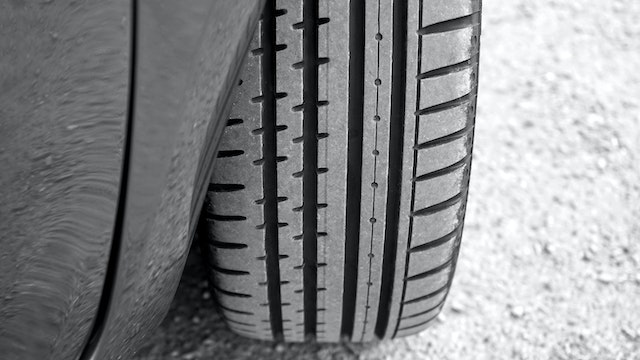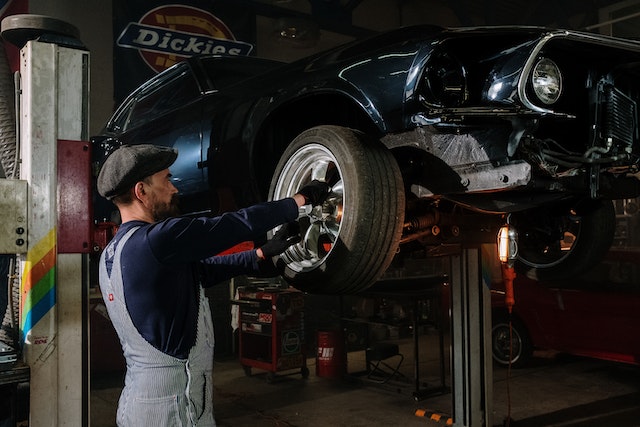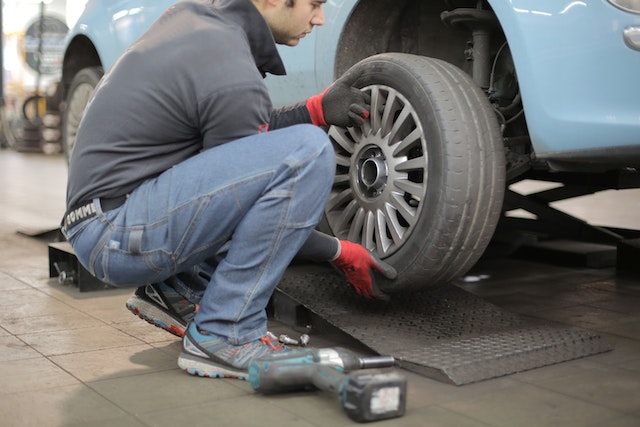Tire rotation is an essential aspect of tire maintenance that helps to ensure even wear and prolong the life of your tires. It involves moving the front tires to the back and vice versa, and also swapping the left and right tires. The process helps to distribute the weight of the vehicle evenly across all four tires, which reduces the risk of uneven wear and tear.
While tire rotation is an important maintenance procedure, it comes at a cost. The cost of tire rotation varies depending on various factors such as the type of vehicle, the type of tires, the location, and the service provider. In this article, we will take a closer look at tire rotation cost and what factors affect it. We will also discuss when to rotate your tires, the procedure involved, and the effects of neglecting tire rotation.
Key Takeaways
- Tire rotation is an essential aspect of tire maintenance that helps to ensure even wear and prolong the life of your tires.
- The cost of tire rotation varies depending on various factors such as the type of vehicle, the type of tires, the location, and the service provider.
- Neglecting tire rotation can lead to uneven wear and tear, reduced tire performance, and increased risk of tire failure.
Understanding Tire Rotation
Tire rotation is the process of moving tires from one position to another on a vehicle to ensure even tire wear and extend the life of the tires. It is a routine maintenance service that is recommended by most tire manufacturers and automotive experts.
What is a tire rotation? It involves removing the tires from the vehicle and placing them in a different position. The most common tire rotation pattern is the standard rotation, which involves moving the front tires to the rear and the rear tires to the front. However, there are other rotation patterns that may be recommended depending on the type of tires and the vehicle.
One example of a tire type that requires a specific rotation pattern is directional tires. These tires have an arrow on the sidewall that indicates the direction of rotation. They must be rotated in a specific way to maintain their performance and prevent uneven wear.
There are different tire rotation patterns, including the forward cross, rearward cross, and side-to-side rotation. The forward cross involves moving the front tires to the opposite side of the rear and the rear tires to the opposite side of the front in an X pattern. The rearward cross is the opposite of the forward cross, and the side-to-side pattern involves moving the tires from side to side.
The choice of rotation pattern will depend on the type of tires, vehicle, and driving conditions. A knowledgeable mechanic can recommend the best rotation pattern for a particular vehicle.
Overall, tire rotation is an essential maintenance service that can help extend the life of tires and improve vehicle performance. It is recommended that tires be rotated every 5,000 to 7,000 miles or as recommended by the vehicle manufacturer.
Importance of Tire Rotation
Tire rotation is an essential maintenance task that should not be overlooked by vehicle owners. It involves moving tires from one position to another to promote even tread wear and extend the life of the tires. In this section, we will discuss the importance of tire rotation and why it should be done regularly.
Prevents Uneven Tire Wear
One of the main reasons why tire rotation is crucial is that it helps prevent uneven tire wear. Tires wear out at different rates depending on their position on the vehicle, driving style, and driving habits. For instance, the front tires wear out faster than the rear ones because they bear the brunt of braking and steering forces. By rotating the tires regularly, the wear pattern is spread evenly across all four tires, and they last longer.
Improves Alignment
Tire rotation also helps improve alignment. Misaligned wheels cause uneven tire wear, which can lead to a host of problems such as vibration, poor handling, and reduced fuel efficiency. By rotating the tires, the mechanic can check and correct the alignment, ensuring that the tires wear evenly and the vehicle drives smoothly.
Promotes Even Tread Wear
Tire rotation promotes even tread wear. When the tires wear evenly, they maintain better traction, which improves braking and handling. Uneven tread wear, on the other hand, can cause the tires to lose traction, especially in wet or slippery conditions, making the vehicle more prone to accidents.
Reduces Vibration
Rotating the tires can also reduce vibration. Uneven tire wear can cause the wheels to become unbalanced, leading to vibration and discomfort when driving. By rotating the tires, the mechanic can rebalance the wheels, ensuring a smoother and more comfortable ride.
Prevents Punctures
Finally, tire rotation can prevent punctures. Uneven tire wear can cause the tires to develop weak spots, making them more susceptible to punctures. By rotating the tires, the mechanic can inspect them for signs of wear and tear, and replace them if necessary, reducing the risk of a flat tire on the road.
In conclusion, tire rotation is an essential maintenance task that promotes even wear, improves alignment, and extends the life of the tires. Vehicle owners should have their tires rotated regularly to ensure a safe and comfortable driving experience.
Tire Rotation Cost Factors
Tire rotation is an important part of tire maintenance that helps to ensure even wear and prolong the life of your tires. The cost of tire rotation can vary depending on a number of factors, including the location of the service, the type of vehicle, and the services included in the rotation.
Location
The cost of tire rotation can vary depending on the location of the service. For example, tire rotation at a Jiffy Lube or other quick lube service may be less expensive than at a car dealer or warehouse store. However, it is important to consider the quality of service and experience of the technicians when choosing a location for tire rotation.
Services Included
The cost of tire rotation may also vary depending on the services included in the rotation. Some services may include tire balancing, which can help to ensure a smooth ride and even wear on the tires. Other services may include tire replacement or oil change, which can affect the overall cost of the rotation.
Free Rotation
Some tire retailers may offer free tire rotation as part of a tire purchase or tire maintenance package. This can be a cost-effective option for those who are looking to save money on tire rotation.
Overall, the cost of tire rotation can vary depending on a number of factors. It is important to consider the location, services included, and any promotions or discounts that may be available when choosing a service for tire rotation.
When to Rotate Tires
Tire rotation is an essential aspect of tire maintenance that helps to ensure even wear and prolong the lifespan of your tires. It is recommended that tires be rotated every 5,000 to 7,500 miles, depending on the type of vehicle and driving conditions.
New tires should be rotated after the first 5,000 miles of use, as this helps to ensure that they wear evenly and last longer. The owner’s manual of your vehicle will provide specific recommendations on when to rotate your tires, so it is important to refer to this document for guidance.
It is also important to note that tire manufacturers may have specific recommendations on tire rotation schedules, so it is advisable to follow these guidelines as well. Failure to follow the recommended rotation schedule may void your tire warranty, so it is crucial to adhere to the guidelines provided by the manufacturer.
When scheduling a tire rotation appointment, it is important to consider the mileage on your vehicle, as well as the type of driving conditions you encounter on a regular basis. Vehicles that are driven on rough or unpaved roads may require more frequent tire rotations to ensure even wear.
In summary, tire rotation is an important aspect of tire maintenance that helps to ensure even wear and prolong the lifespan of your tires. It is recommended that tires be rotated every 5,000 to 7,500 miles, depending on the type of vehicle and driving conditions. It is important to refer to the owner’s manual and follow the guidelines provided by the tire manufacturer to avoid voiding your tire warranty.
Tire Rotation Procedure
Tire rotation is a process of moving tires from one position to another on a vehicle. This procedure is necessary to ensure even wear and extend the life of tires. Proper tire rotation can also improve vehicle handling and safety. In this section, we will discuss the tire rotation procedure and some important considerations.
The first step in tire rotation is to identify the tire rotation pattern recommended by the vehicle manufacturer. This information can usually be found in the owner’s manual or on a sticker located on the driver’s side door jamb. The most common tire rotation patterns are front-to-back, rear-to-front, and cross-pattern.
Before starting the tire rotation, it is important to make sure that the lug nuts are properly torqued. Lug nuts are the fasteners that hold the wheels to the vehicle. Over-tightening or under-tightening the lug nuts can cause damage to the wheels or create a safety hazard. The lug nuts should be torqued to the manufacturer’s specification using a torque wrench.
The next step is to jack up the vehicle and remove the wheels. It is important to use the correct jacking points specified by the vehicle manufacturer. Once the wheels are removed, inspect the tires for any signs of damage or uneven wear. If any issues are found, they should be addressed before proceeding with the rotation.
The tire rotation pattern should be followed carefully to ensure that each tire is moved to the correct position. For example, if the vehicle is front-wheel drive, the front tires should be moved to the rear and the rear tires should be moved to the front. If the vehicle is rear-wheel drive, the rear tires should be moved to the front and the front tires should be moved to the rear. For all-wheel drive vehicles, the manufacturer’s recommended rotation pattern should be followed.
After the tires have been rotated, the lug nuts should be torqued again to the manufacturer’s specification. This is important to ensure that the wheels are properly secured to the vehicle.
In summary, tire rotation is an important procedure that should be performed regularly to ensure even wear and extend the life of tires. Proper torque of lug nuts, careful inspection of tires, and following the manufacturer’s recommended rotation pattern are all important considerations for a successful tire rotation.
Effects of Neglecting Tire Rotation
Neglecting tire rotation can have a number of negative effects on a vehicle’s performance, safety, and overall cost of ownership. Here are some of the most common effects:
Uneven Wear
Tire rotation helps to ensure that all four tires wear evenly over time. When tires are left in the same position for too long, they can develop uneven wear patterns. This can lead to decreased traction, increased road noise, and a rougher ride. Uneven wear can also cause tires to wear out more quickly, which means that they will need to be replaced more often.
Hydroplaning
Hydroplaning occurs when a vehicle’s tires lose contact with the road surface and start to slide on a layer of water. This can be a dangerous situation, especially at high speeds or on wet roads. One of the main causes of hydroplaning is worn tires, which can’t grip the road as well as new tires. Regular tire rotation can help to prevent uneven wear and keep tires in good condition, which can reduce the risk of hydroplaning.
Worn Tires
Neglecting tire rotation can also lead to premature tire wear. When tires wear out too quickly, they need to be replaced more often, which can be expensive. In addition, worn tires can be dangerous, as they may not provide adequate traction on the road. This can increase the risk of accidents, especially in wet or slippery conditions.
Overall, it’s important to make sure that tires are rotated regularly to ensure even wear, reduce the risk of hydroplaning, and extend the life of the tires.
Additional Tire Maintenance Tips
In addition to regular tire rotations, there are other tire maintenance tips that can help extend the life of your tires and ensure they perform optimally. Here are a few tips to keep in mind:
- Maintain Proper Tire Pressure: Proper tire pressure is essential for optimal tire performance and longevity. It’s important to check tire pressure regularly and inflate tires to the recommended pressure listed in your vehicle owner’s manual or on the tire placard located in the driver’s side door jamb.
- Balance Your Tires: Balancing your tires helps ensure even wear and a smooth ride. If you notice vibration or shaking while driving, it may be a sign that your tires are out of balance and need to be balanced by a professional.
- Check Your Speed Rating: Each tire has a speed rating that indicates the maximum speed at which it can safely operate. It’s important to ensure that your tires have a speed rating that matches or exceeds the maximum speed of your vehicle.
- Inspect Your Tires Regularly: Regular tire inspections can help identify potential issues before they become major problems. Inspect your tires for signs of wear, damage, or punctures, and replace them as needed.
By following these additional tire maintenance tips, you can help ensure that your tires last as long as possible and perform at their best.
Frequently Asked Questions
What is the average cost of tire rotation at a dealership?
The average cost of tire rotation at a dealership ranges from $20 to $100. The cost may vary depending on the location, the type of vehicle, and the dealership’s pricing policy.
What is the cost of tire rotation at Firestone?
The cost of tire rotation at Firestone ranges from $20 to $30. Firestone offers free tire rotation to customers who purchase a new set of tires from them.
How much does Valvoline charge for tire rotation?
Valvoline charges $20 for tire rotation. The company also offers a tire rotation service as part of their oil change package.
What is the cost of tire rotation at Discount Tire?
The cost of tire rotation at Discount Tire ranges from $10 to $30. The price may vary depending on the location and the type of vehicle.
How much does Costco charge for tire rotation?
Costco charges $15 for tire rotation. The company also offers a tire rotation service as part of their tire installation package.
How often should you rotate your tires?
It is recommended to rotate your tires every 6,000 to 8,000 miles or every six months, whichever comes first. Tire rotation helps to ensure even wear and prolongs the life of your tires.





